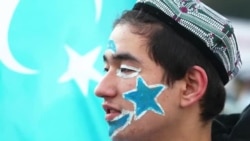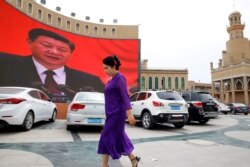On March 21, the U.S. State Department imposed visa restrictions on Chinese officials allegedly responsible for rights abuses, including the repression of “ethnic minority groups.”
In January 2021, the United States became the first country to officially describe China’s treatment of one such group – the Uyghur Muslim minority in China’s northwestern Xinjiang region – as genocide.
More than 1 million Uyghurs and other ethnic minorities have allegedly been subjected to mass internment, forced sterilization and labor, torture, religious repression and other forms of cultural erasure.
On March 21, Deng Xijun, China’s ambassador to the Association of Southeast Asian nations, shared a video clip from New China TV, the official YouTube Channel of China’s Xinhua News Agency. The clip includes excerpts of an interview with William Jones, Washington bureau chief for the news magazine Executive Intelligence Review, in which he disputes any genocide in Xinjiang.
“The allegation of so-called genocide in China’s Xinjiang Uygur Autonomous Region is fabricated by some western media outlets and a total farce,” the New China TV video summarizes Jones as saying.
Jones repeats various bogus Beijing talking points, including:
- People in Xinjiang are still speaking and being educated in their own language(s).
- People in Xinjiang are still practicing their own religion.
- More mosques are being built in Xinjiang than anywhere else in the world.
- The population of Xinjiang is growing.
Polygraph.info and other fact checkers have previously debunked many of these claims.
Executive Intelligence Review was founded in 1974 by Lyndon LaRouche, a fringe U.S. political activist and failed presidential candidate often described as ‘cultlike,’ who died in 2019.
“‘Journalists’ associated with the LaRouche’s news outlet, the Executive Intelligence Review, are regularly invited to Chinese government press conferences in Washington and are quoted extensively in Chinese state media, where they often parrot government propaganda,” The Intelligencer, an offshoot of New York magazine, wrote in its February 2019 obituary of LaRouche.
“[T]here’s the dangerous possibility that Chinese officials and academics actually think the LaRouche movement is a serious Western group.”
Jones is also a nonresident fellow at the Chongyang Institute for Financial Studies, a Chinese think tank.
Many of Jones’ claims regarding Xinjiang are misleading, if not false. For example, while Uyghurs still communicate in their own language, China has tried to reduce its place in society.
In June 2017, authorities in Xinjiang’s Hotan prefecture, which is largely populated by Uyghurs, banned the use of the Uyghur language at schools in favor of Mandarin Chinese, “in order to strengthen elementary and middle/high school bilingual education,” Radio Free Asia, a VOA sister news outlet, reported.
Thousands of Uyghur children have been placed in Mandarin-only orphanages and boarding schools, where children described being “hit with rulers” if they spoke Uyghur.
In December 2021, the U.K.’s Guardian newspaper reported that no Uyghur-language books had been published in China since 2017.
Textbooks that taught classic poems and folk tales were banned, in what some experts said was a systematic effort to keep young Uyghurs from learning their language and culture.
“It’s a slow process of cultural re-engineering to reshape Uyghur culture from top to bottom – to eradicate most fundamentally the Uyghur language, or to erode it to the extent that among younger generations, it might potentially die out,” James Leibold, a scholar of Chinese ethnic studies at LaTrobe University in Melbourne, Australia, told The Associated Press.
The year 2017 marked a turning point both in the crackdown on language education and repression in Xinjiang, with reports of mass internment camps, religious and cultural repression and other systematic rights abuses. And while Jones claims Xinjiang’s Uyghur population has been growing, 2017 saw a decline.
Chinese authorities claim Xinjiang’s population grew 18.5 percent between 2010 and 2020. But Rian Thum, a historian of Islam in China and the Uyghurs at the U.K.’s University of Manchester, says that time frame does not count what happened from 2017 onward, when “Uyghur births were brutally suppressed.”
“It's telling that they won't tell us what the *current* population growth rate for Uyghurs is. How did 2020 compare to 2019? This would seem to b[e] crucial data for a state looking to convince the world that it is not preventing births in an indigenous group,” he tweeted.
In 2015, the year the Chinese Communist Party (CCP) government began linking population growth to “religious extremism,” natural population growth decreased across all Chinese minority regions, according to Adrian Zenz, a scholar on the People’s Republic of China who has reported extensively on Xinjiang.
In his research paper, “Sterilizations, IUDs, and Mandatory Birth Control: The CCP’s Campaign to Suppress Uighur Birthrates in Xinjiang,” Zenz wrote that in 2010, nine of the top 10 Chinese counties with the highest natural population growth rates — as much as five times the national average — had large Uyghur or Kyrgyz populations.
“Natural population growth in Xinjiang has declined dramatically; growth rates fell by 84 percent in the two largest Uyghur prefectures between 2015 and 2018, and declined further in several minority regions in 2019,” Zenz wrote.
Zenz linked that population growth decline to a Chinese government campaign to cut Uyghur and other ethnic minority birth rates through measures that included pregnancy checks, forced intrauterine devices, sterilization, abortions and extrajudicial internment for birth control violations.
According to Zenz, this proves that Beijing is carrying out a campaign of genocide under the U.N. Convention on the Prevention and Punishment of the Crime of Genocide, which states that genocide includes “imposing measures intended to prevent births within the group.”
“The case for demographic genocide and the atrocity is of course based on dramatic [population] declines starting in 2017, draconian sterilization targets for 2019, plus punishing birth control violations with internment, a policy that started in 2018,” Zenz told Polygraph.info in November 2020. “Also, a near-zero birth rate target for Kizilsu prefecture for 2020.”
Chinese state media accuse Zenz, whose research is widely cited in Western media reports, of being “a right-wing Christian” seeking to slander the CCP.
But publicly available information supports his claims.
According to the China Statistical Yearbook 2020, compiled by China’s National Bureau of Statistics, Xinjiang’s natural population growth rate fell from 11.4 per 1,000 in 2017 to 3.7 per 1,000 in 2019. That 68 percent decline far exceeded the national average.
Likewise, while China claims Xinjiang has more mosques per capita than many Muslim countries, there is much evidence China’s government has destroyed thousands of mosques and other religious sites in the region.
Beijing’s broader efforts to curtail Uyghur religious and social life have also been documented.
These include the destruction of traditional Uyghur architectural and design elements and the replacement of home furnishings with more “sinicized” household items.
Uyghurs have reportedly been compelled to eat pork and drink alcohol, which are forbidden by Islam. In October 2020, Chinese authorities reportedly banned Muslim believers from making private pilgrimages to Mecca, one of the five pillars of Islam.
Although Chinese state media have publicized scenes of public dancing to mark Eid al-Fitr – the end of the Muslim holy month of Ramadan – others observers claim such events were staged. Celebratory house visits to mark the occasion were reportedly banned.
State-directed, public displays of dancing, versus organic celebrations, fit into what one expert called “exoticized song-and-dance spectacles that cater to the growing national tourism industry.”
On March 8, Amnesty International and almost 200 other rights organizations sent an open letter to the U.N. High Commissioner for Human Rights urging her to release a “long-awaited report on the Chinese government’s crimes against humanity in the Xinjiang Uyghur Autonomous Region without further delay.”
Polygraph.info reached out to Jones for comment. He had not responded by the time of publication.







